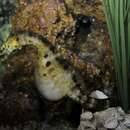Diagnostic Description
(
англиски
)
добавил Fishbase
Description: (based on 17 specimens): Adult height: 8.0-32.0 cm; Rings: 12-13 + 47 (45-48)Snout length: 2.6 (2.2-3.2) in head length; Dorsal fin rays: 27-28 (25-29) covering 4+1 rings; Pectoral fin rays: 15-17; Caudal fin absent; Coronet: low, triangular wedge; Spines: low, rounded bumps only.Other distinctive characters: (very) prominent rounded eye spines; often with thick fronds attached to head region; very deep body with keel (especially females); mature males have extremely prominent (usually white) brood pouch.Color pattern: pale, near white to mottled yellow to variable brown; dark spots and splotches on head and trunk; tail with alternating dark and light bands; dorsal fin mottled; males have more dark blotches than females and commonly have a yellow slash near the top of the pouch 34.
- лиценца
- cc-by-nc
- авторски права
- FishBase
- Recorder
- Cristina V. Garilao
Life Cycle
(
англиски
)
добавил Fishbase
Several subsequent broods are carried by the male in a brood pouch during the spawning season. Do not obviously pair, as other seahorses do (Ref. 30915). Fertilised eggs deposited by females in the pouch of males are incubated for about four weeks before hatching (Ref. 31838). Hatching occurs at night, coinciding with full moon periods during summer months (Ref. 31838). Young emerge from the pouch and immediately rise to the surface where they grasp floating debris with their tail (Ref. 31838).
- лиценца
- cc-by-nc
- авторски права
- FishBase
Morphology
(
англиски
)
добавил Fishbase
Dorsal spines (total): 0; Dorsal soft rays (total): 25 - 31; Analspines: 0; Analsoft rays: 4
- лиценца
- cc-by-nc
- авторски права
- FishBase
- Recorder
- Cristina V. Garilao
Trophic Strategy
(
англиски
)
добавил Fishbase
Found among algae, seagrasses and rocky reefs in shallow water; attached to sponges and colonial hydroids in deeper water; also around jetty piles and other man-made objects (Ref. 30915). No differences in diet between male and female seahorses; smaller seahorses consumed a greater amount of crustaceans than larger seahorses; amphipod consumption peaking in spring and summer, and decapod consumption lowest in autumn (Ref. 73407). Observed hunting among the algal blades for prey as well as the surrounding substratum while hitched to the macroalgae, e.g., hunting the epibenthic swarming mysid Tenagomysis similis over sand while attached to the macroalgae fringing sand (Ref. 73407).
- лиценца
- cc-by-nc
- авторски права
- FishBase
Biology
(
англиски
)
добавил Fishbase
Found in large rock pools at low tide. They remain motionless amidst seaweed. Juveniles are pelagic (Ref. 30915) or attached to drifting seaweeds (Ref. 31838). Feed on minute crustaceans (e.g. copepods and amphipods). Nocturnal (Ref. 9003). Ovoviviparous (Ref. 205). The male carries the eggs in a brood pouch which is found under the tail (Ref. 205). Seen in groups at night. Also around jetties and other man-made objects; attached to sponges and colonial hydroids in deeper water (Ref. 30915). Length measurements refer to height (= TL - head length).This is the largest seahorse species in southeastern Australia, and has more dorsal fin rays and tail rings than any other seahorse (Ref. 31838). Sold locally and internationally for the aquarium trade (Ref. 31838). Dried and sold to the Oriental medicine trade as a tonic and aphrodisiac (Ref. 5316, 34026).
- лиценца
- cc-by-nc
- авторски права
- FishBase
- Recorder
- Cristina V. Garilao
Importance
(
англиски
)
добавил Fishbase
fisheries: of no interest; aquarium: commercial
- лиценца
- cc-by-nc
- авторски права
- FishBase
- Recorder
- Cristina V. Garilao

